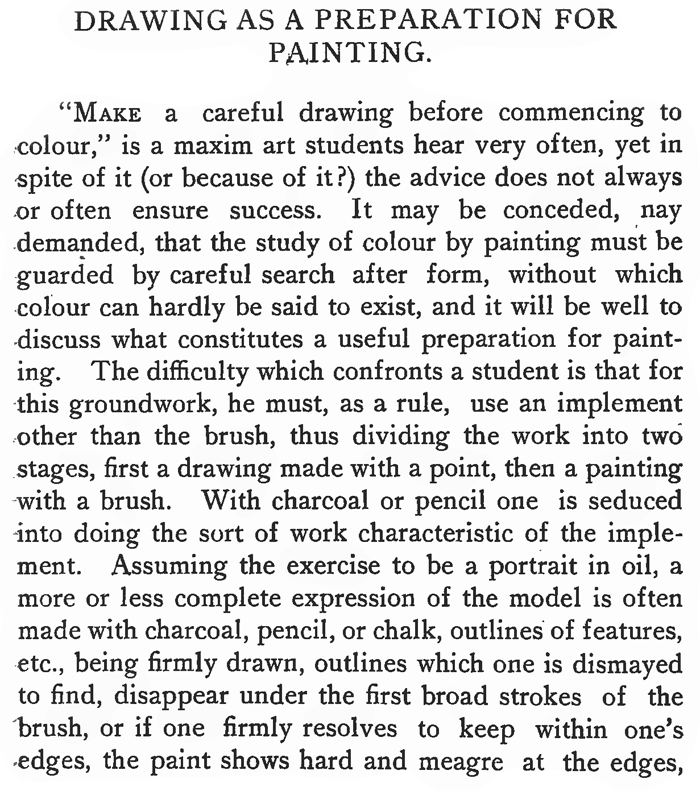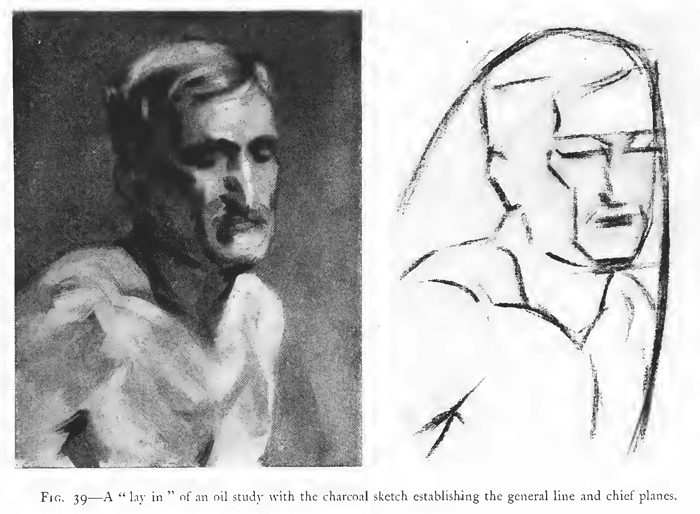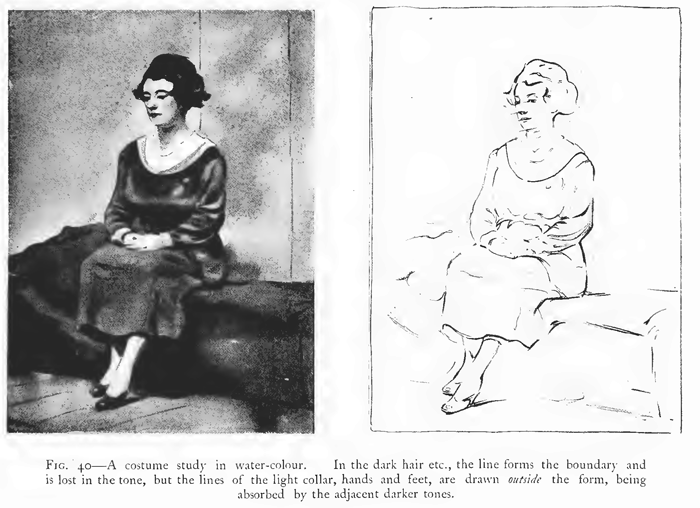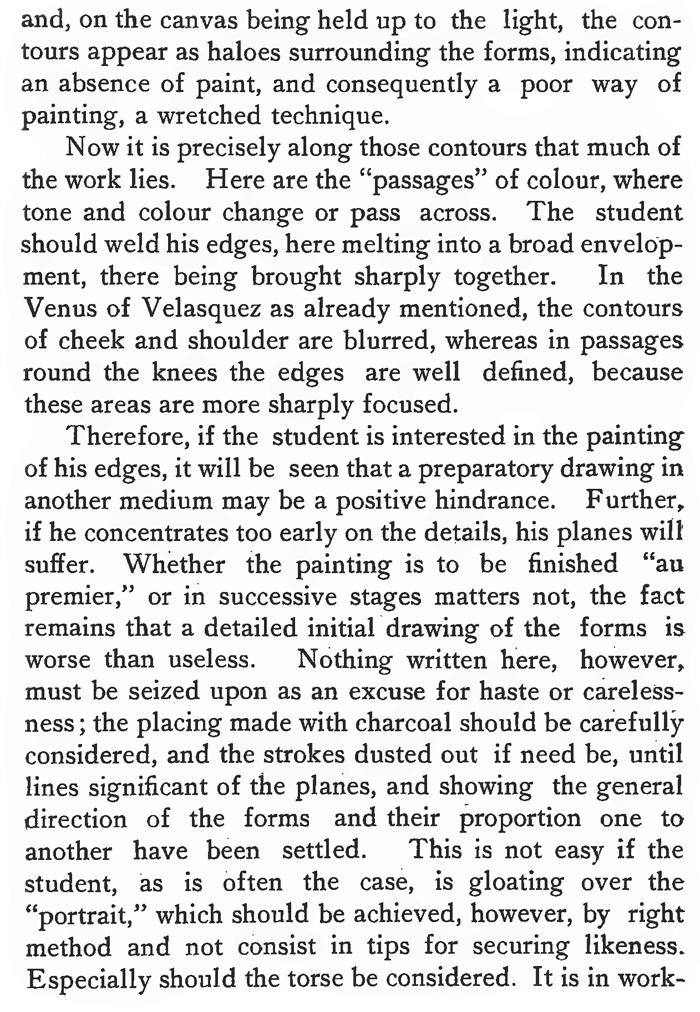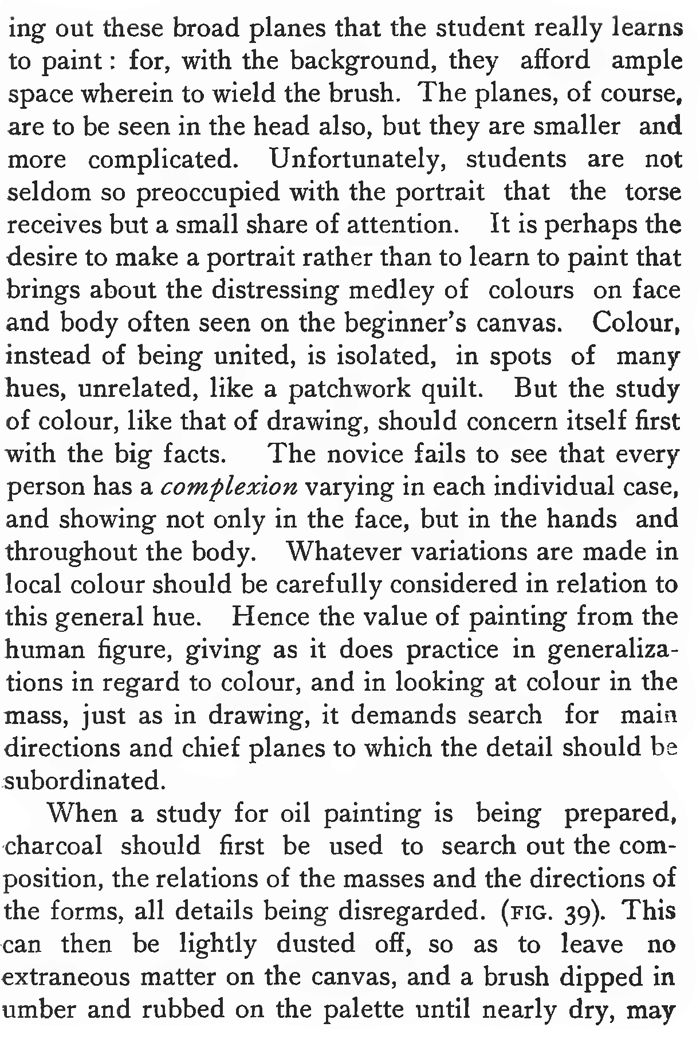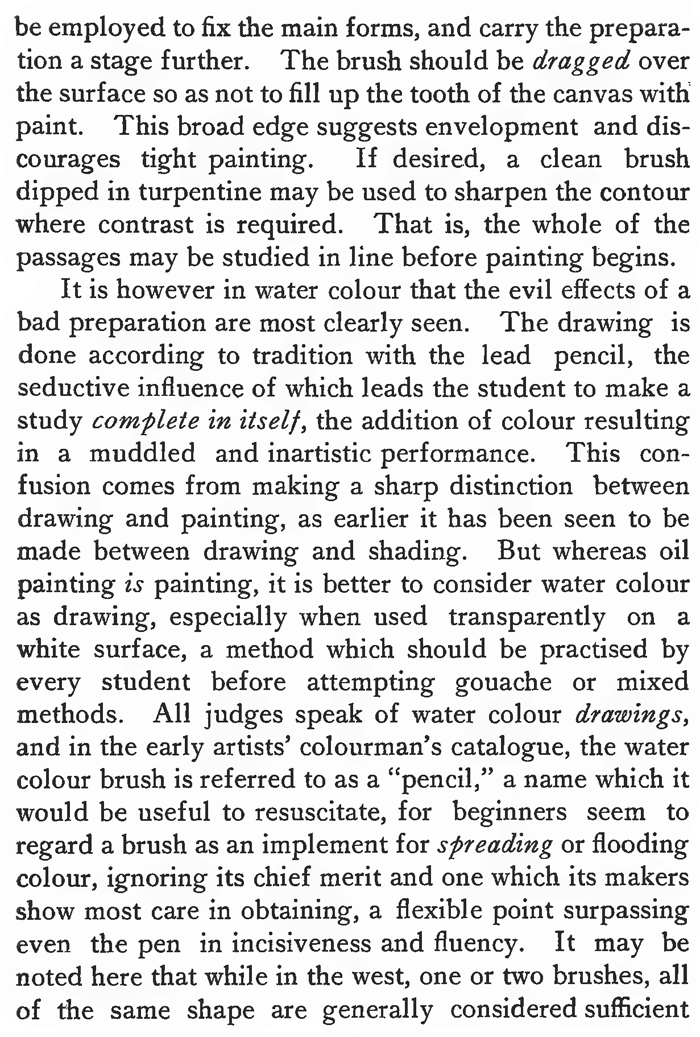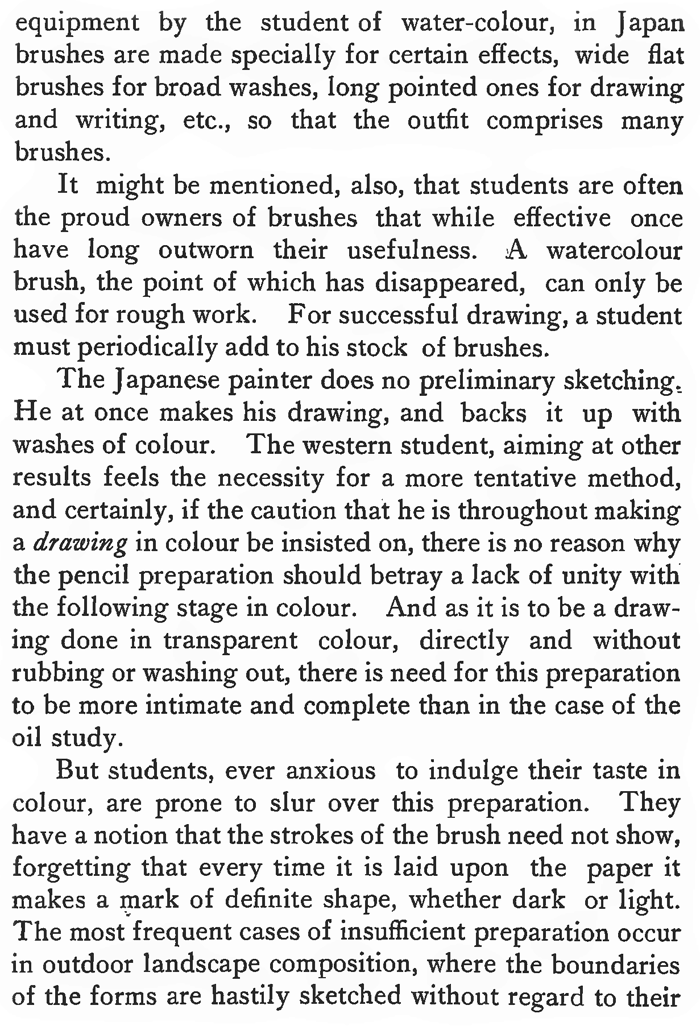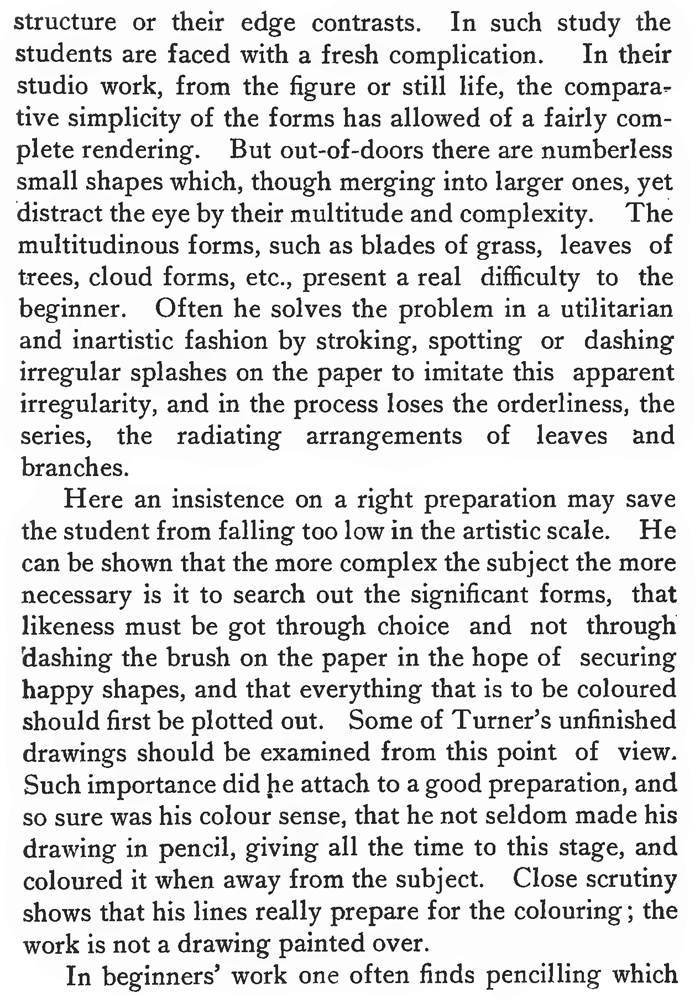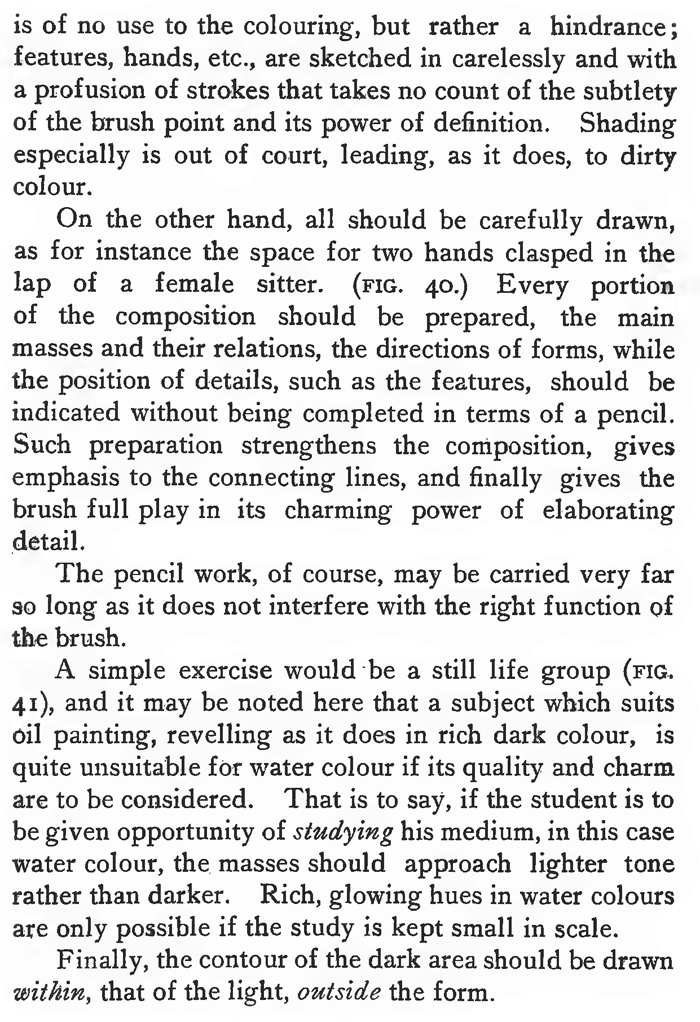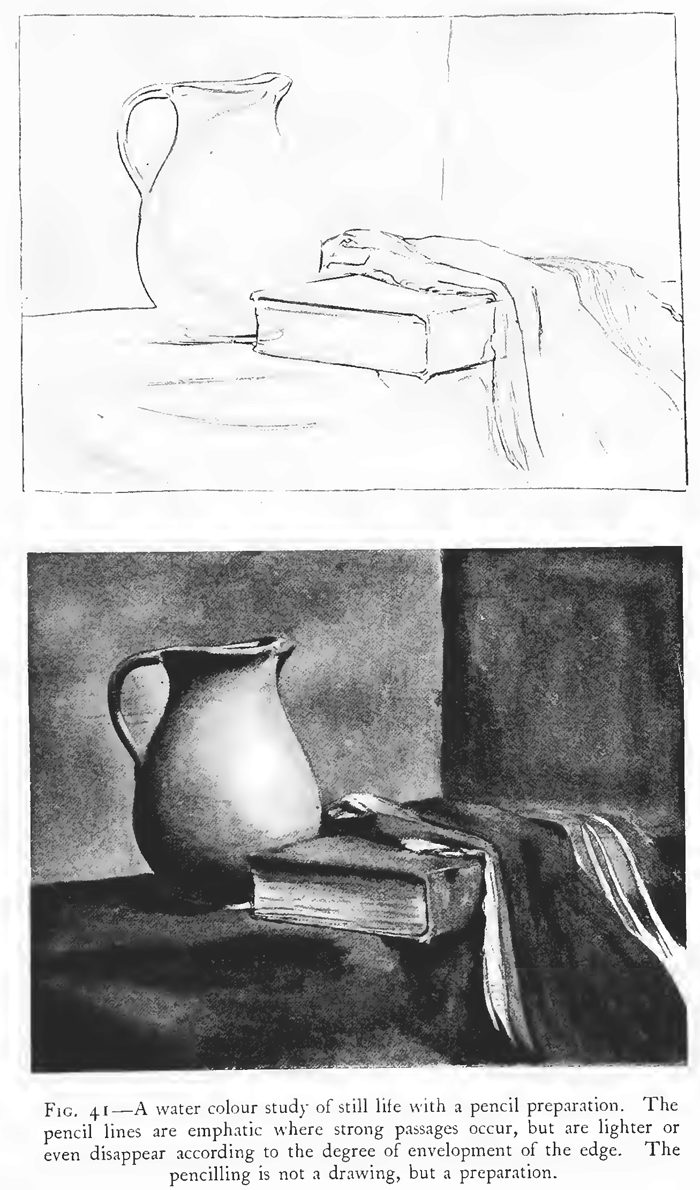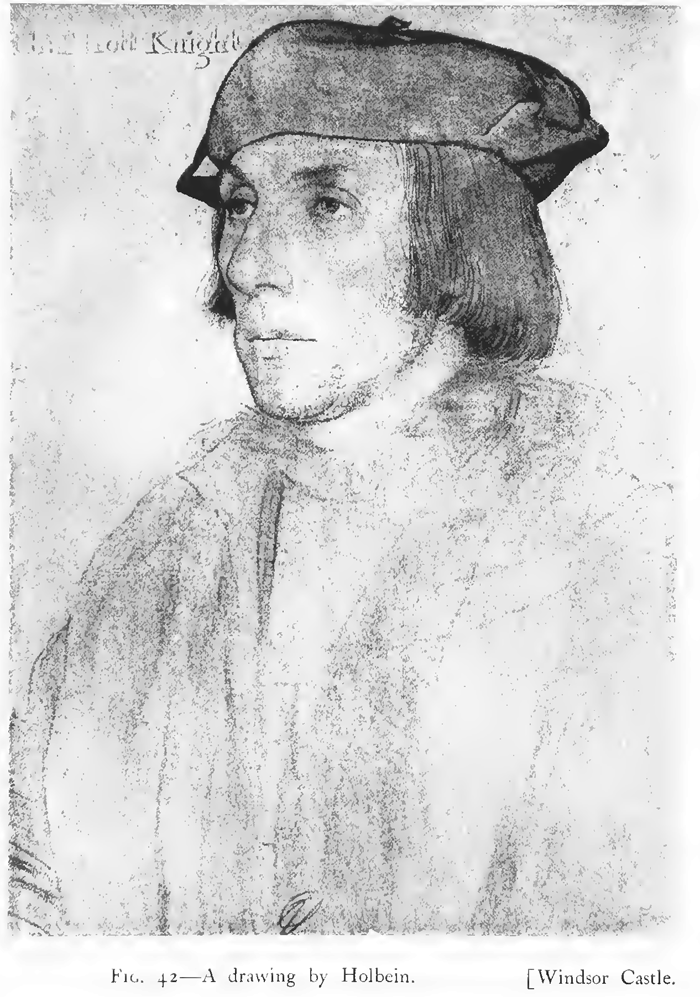Home > Directory of Drawing Lessons > How to Improve Your Drawings > Sketching Before Painting > Drawing as Preparation for Paintings
sHOULD YOU DRAW SKETCHES ON YOUR CANVAS, PANEL, OR WATERCOLOR PAPER BEFORE PAINTING
|
|
The text above is made up of images, to copy some text, it is below. DRAWING AS A PREPARATION FOR PAINTING."Make a careful drawing before commencing to color," is a maxim art students hear very often, yet in spite of it (or because of it?) the advice does not always or often ensure success. It may be conceded, ,nay demanded, that the study of color by painting must be guarded by careful search after form, without which color can hardly be said to exist, and it will be well to discuss what constitutes a useful preparation for painting. The difficulty which confronts a student is that for this groundwork, he must, as a rule, use an implement other than the brush, thus dividing the work into two stages, first a drawing made with a point, then a painting with a brush. With charcoal or pencil one is seduced into doing the sort of work characteristic of the implement. Assuming the exercise to be a portrait in oil, a more or less complete expression of the model is often made with charcoal, pencil, or chalk, outlines of features, etc., being firmly drawn, outlines which one is dismayed to find, disappear under the first broad strokes of the brush, or if one firmly resolves to keep within one's edges, and, on the canvas being held up to the light, the contours appear as haloes surrounding the forms, indicating an absence of paint, and consequently a poor way of painting, a wretched technique. Now it is precisely along those contours that much of the work lies. Here are the "passages" of color, where tone and color change or pass across. The student should weld his edges, here melting into a broad envelopment, there being brought sharply together. In the Venus of Velasquez as already mentioned, the contours of cheek and shoulder are blurred, whereas in passages round the knees the edges are well defined, because these areas are more sharply focused. FIG. 40 —A costume study in color In the dark hair etc., the line forms the boundary and
is lost in the tone, but the lines of the light collar, hands and feet, are drawn outside the form, being Therefore, if the student is interested in the painting of his edges, it will be seen that a preparatory drawing in another medium may be a positive hindrance. Further, if he concentrates too early on the details, his planes will suffer. Whether the painting is to be finished "au premier," or in successive stages matters not, the fact remains that a detailed initial drawing of the forms is worse than useless. Nothing written here, however, must be seized upon as an excuse for haste or carelessness; the placing made with charcoal should be carefully considered, and the strokes dusted out if need be, until lines significant of the planes, and showing the general direction of the forms and their proportion one to another have been settled. This is not easy if the student, as is often the case, is gloating over the "portrait," which should be achieved, however, by right method and not consist in tips for securing likeness. Especially should the torso be considered. It is in working out these broad planes that the student really learns to paint : for, with the background, they afford ample space wherein to wield the brush. The planes, of course, are to be seen in the head also, but they are smaller and more complicated. Unfortunately, students are not seldom so preoccupied with the portrait that the torso receives but a small share of attention. It is perhaps the desire to make a portrait rather than to learn to paint that brings about the distressing medley of colors on face and body often seen on the beginner's canvas. Color, instead of being united, is isolated, in spots of many hues, unrelated, like a patchwork quilt. But the study of color, like that of drawing, should concern itself first with the big facts. The novice fails to see that every person has a complexion varying in each individual case, and showing not only in the face, but in the hands and throughout the body. Whatever variations are made in local color should be carefully considered in relation to this general hue. Hence the value of painting from the human figure, giving as it does practice in generalizations in regard to color, and in looking at color in the mass, just as in drawing, it demands search for main directions and chief planes to which the detail should be subordinated. When a study for oil painting is being prepared, charcoal should first be used to search out the composition, the relations of the masses and the directions of the forms, all details being disregarded. (FIG. 39). This can then be lightly dusted off, so as to leave no extraneous matter on the canvas, and a brush dipped in umber and rubbed on the palette until nearly dry, may be employed to fix the main forms, and carry the preparation a stage further. The brush should be dragged over the surface so as not to fill up the tooth of the canvas with paint. This broad edge suggests envelopment and discourages tight painting. If desired, a clean brush dipped in turpentine may be used to sharpen the contour where contrast is required. That is, the whole of the passages may be studied in line before painting begins. It is however in water color that the evil effects of a bad preparation are most clearly seen. The drawing is done according to tradition with the lead pencil, the seductive influence of which leads the student to make a study complete in itself, the addition of color resulting in a muddled and inartistic performance. This confusion comes from making a sharp distinction between drawing and painting, as earlier it has been seen to be made between drawing and shading. But whereas oil painting is painting, it is better to consider water color as drawing, especially when used transparently on a white surface, a method which should be practiced by every student before attempting gouache or mixed methods. All judges speak of water color drawings, and in the early artists' colourman's catalogue, the water color brush is referred to as a "pencil," a name which it would be useful to resuscitate, for beginners seem to regard a brush as an implement for spreading or flooding color, ignoring its chief merit and one which its makers show most care in obtaining, a flexible point surpassing even the pen in incisiveness and fluency. It may be noted here that while in the west, one or two brushes, all of the same shape are generally considered sufficient equipment by the student of color, in Japan brushes are made specially for certain effects, wide flat brushes for broad washes, long pointed ones for drawing and writing, etc., so that the outfit comprises many brushes. It might be mentioned, also, that students are often the proud owners of brushes that while effective once have long outworn their usefulness. A watercolor brush, the point of which has disappeared, can only be used for rough work. For successful drawing, a student must periodically add to his stock of brushes. The Japanese painter does no preliminary sketching. He at once makes his drawing, and backs it up with washes of color The western student, aiming at other results feels the necessity for a more tentative method, and certainly, if the caution that he is throughout making a drawing in color be insisted on, there is no reason why the pencil preparation should betray a lack of unity with the following stage in color And as it is to be a drawing done in transparent color, directly and without rubbing or washing out, there is need for this preparation to be more intimate and complete than in the case of the oil study. But students, ever anxious to indulge their taste in color, are prone to slur over this preparation. They have a notion that the strokes of the brush need not show, forgetting that every time it is laid upon the paper it makes a mark of definite shape, whether dark or light. The most frequent cases of insufficient preparation occur in outdoor landscape composition, where the boundaries of the forms are hastily sketched without regard to their structure or their edge contrasts. In such study the students are faced with a fresh complication. In their studio work, from the figure or still life, the comparative simplicity of the forms has allowed of a fairly complete rendering. But out-of-doors there are numberless small shapes which, though merging into larger ones, yet distract the eye by their multitude and complexity. The multitudinous forms, such as blades of grass, leaves of trees, cloud forms, etc., present a real difficulty to the beginner. Often he solves the problem in a utilitarian and inartistic fashion by stroking, spotting or dashing irregular splashes on the paper to imitate this apparent irregularity, and in the process loses the orderliness, the series, the radiating arrangements of leaves and branches. Here an insistence on a right preparation may save the student from falling too low in the artistic scale. He can be shown that the more complex the subject the more necessary is it to search out the significant forms, that likeness must be got through choice and not through 'dashing the brush on the paper in the hope of securing happy shapes, and that everything that is to be colored should first be plotted out. Some of Turner's unfinished drawings should be examined from this point of view. Such importance did lie attach to a good preparation, and so sure was his color sense, that he not seldom made his drawing in pencil, giving all the time to this stage, and colored it when away from the subject. Close scrutiny shows that his lines really prepare for the coloring ; the work is not a drawing painted over. In beginners' work one often finds penciling which is of no use to the coloring, but rather a hindrance; features, hands, etc., are sketched in carelessly and with a profusion of strokes that takes no count of the subtlety of the brush point and its power of definition. Shading especially is out of court, leading, as it does, to dirty color On the other hand, all should be carefully drawn, as for instance the space for two hands clasped in the lap of a female sitter. (FIG. 40.) Every portion of the composition should be prepared, the main masses and their relations, the directions of forms, while the position of details, such as the features, should be indicated without being completed in terms of a pencil. Such preparation strengthens the composition, gives emphasis to the connecting lines, and finally gives the brush full play in its charming power of elaborating detail. The pencil work, of course, may be carried very far so long as it does not interfere with the right function of the brush. A simple exercise would be a still life group (FIG. 41), and it may be noted here that a subject which suits oil painting, reveling as it does in rich dark color, is quite unsuitable for water color if its quality and charm are to be considered. That is to say, if the student is to be given opportunity of studying his medium, in this case water color, the, masses should approach lighter tone rather than darker. Rich, glowing hues in water colors are only possible if the study is kept small in scale. Finally, the contour of the dark area should be drawn within, that of the light, outside the form. FIG. 41—A water color study of still life with a pencil preparation. The
pencil lines are emphatic where strong passages occur, but are lighter or
even disappear according to the degree of envelopment of the edge. The
penciling is not a drawing, but a preparation. |
Privacy Policy ...... Contact Us





